By Drew Owens
Offensive Coordinator / Offensive Line Coach
Western Connecticut State University
Twitter: @ballcoachDRO
Introduction:
As you can tell from the vast number of reports that X&O Labs has released this winter, RPOs are the hot topic in offensive football. These Run/Pass Option plays are designed to read a certain defender on the field and either run or pass based upon the reaction of that defender. When reading RPO reports, I have noticed that much of the focus has been concentrated on the QB read process or the contours (WR routes / Screens) attached to the play call. While all of these things are important, I think that it is easy to overlook what I consider to be the most important part of an effective RPO; the offensive line.
RPO Philosophy
Here at Western Connecticut, we have a firm RPO philosophy. We will not attach a run to a RPO unless the timing of the RB’s steps, the OL double teams and the QB mesh can allow the QB to make a true option decision to either throw or hand off based upon the read key. With our RB steps and tempo, we are able to attached IZ, OZ, Power, Counter and Dart to any RPO. Conversely, we do not attach RPOs to any inside quick trap or downhill veer runs because of the quick tempo and faster RB steps. We believe that the reads are too fast or the RB’s steps are too fast, therefore not allowing our QB to make a decision based on the read defender. The additional benefits of our RB base zone and gap steps force a read defender to make a decision during the mesh decision window. Through study, we have found that if our runs are too quick, the read player can flat foot and play both the run and the throw.
We also have a firm philosophy that our offensive linemen will never know when we are executing a “read” option play or a “run/pass” option play. I never want my OL to come off the ball slower or hesitant for worry that they will be downfield. To make this work and “slow down” our linemen, we stress first level authority. All of our double teams are graded holistically but the prime stress is on the movement of the first level defender. Our uncovered lineman should always have a body presence on the backside defender when they are doubling. We also stress a “duck demeanor” to all of our offensive linemen. This demeanor naturally slows down our uncovered lineman when “duck walking” to the second level.
Run Game Rules
To be successful in the run game, our linemen must be able to play fast and not think. This is another reason that we don’t want the line to know that the play is an RPO. It is just one more thing for them to think about. It is important to note that we still identify who the “read key” is our offensive linemen. While we might not actually be reading that defender, the linemen know to never block or touch the read key. We teach this defender to be invisible to our linemen and to our count system. For example, the backside defensive end is the read key in inside zone and the front side defensive end is the read key in power. Our offensive line also understands if we block all first level defenders then the read must be at the second or third level. Our running back also understands who these read keys are.
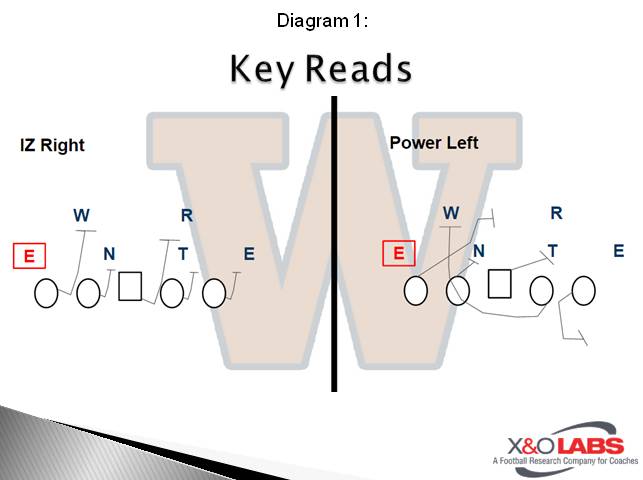
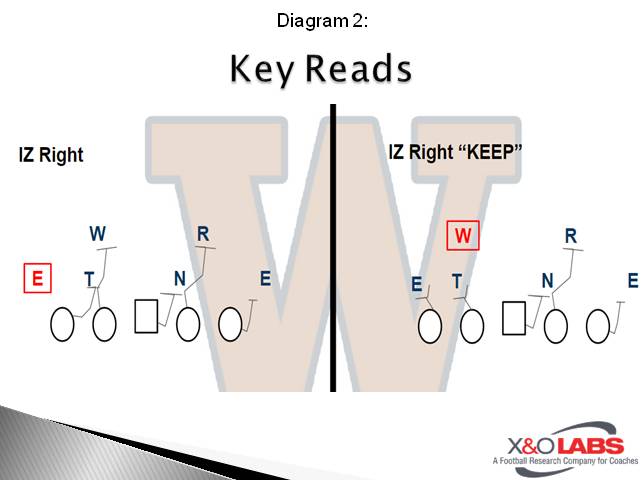
There is a delicate balance with our linemen run game count system and RPO read system. It is critical for these two systems to be in sync. To make sure our QB and linemen are reading the same defender, we will tag our called run play. For instance, the base variation when we call inside zone, the read is automatically by default the backside end. If we want to change the read to a second level defender, we will tag our zone play with a word to tell the linemen to block all 1st level defenders. If we tag our zone play with the word “keep”, our back side tackle and guard understand we must account for all back side defenders on the line of scrimmage (Diagram 3). When our linemen “keep” block, this is always an inside number drive and they are never allowed to have a defender cross their face. We also treat this “keep” side the same as we do for our man side of pass pro. We drill daily on the tagged side to work out twists and reductions.
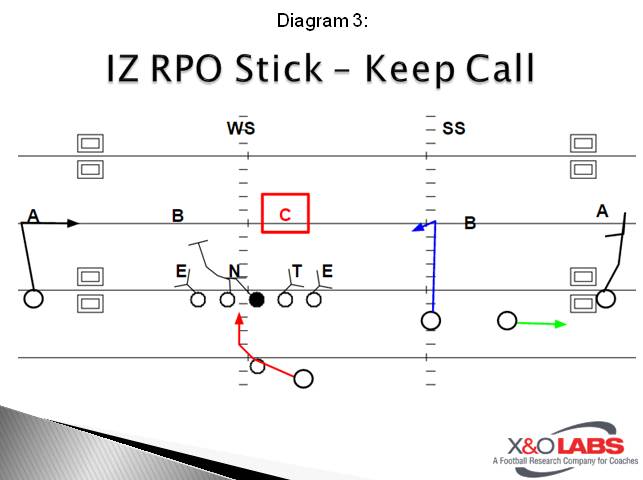
The next way we can account for all first level defenders and read second or third level defenders is by adding a FB or TE into the blocking. When the FB or TE handle the back side end or back side LB, we can now read defenders inside or outside of the box at the second/third levels (Diagram 4). Gap runs do not change anything in the system for the offensive line either (Diagram 5). Our gap runs will never change to account for a new “read” defender. By stressing first level authority, our front side linemen never climb too fast in gap schemes (Power, Counter & Dart).
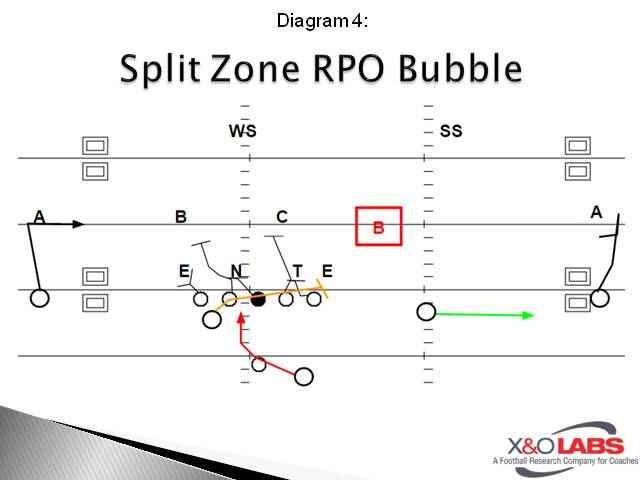
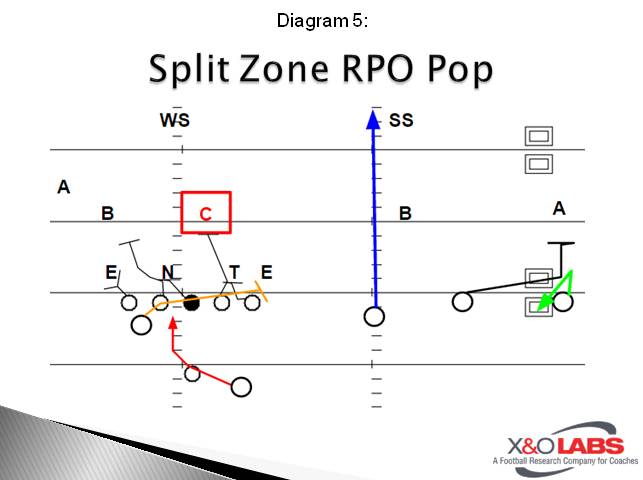
To study game film on these RPO concepts, click on the link below:
Offensive Coordinator / Offensive Line Coach
Western Connecticut State University
Twitter: @ballcoachDRO
Introduction:
As you can tell from the vast number of reports that X&O Labs has released this winter, RPOs are the hot topic in offensive football. These Run/Pass Option plays are designed to read a certain defender on the field and either run or pass based upon the reaction of that defender. When reading RPO reports, I have noticed that much of the focus has been concentrated on the QB read process or the contours (WR routes / Screens) attached to the play call. While all of these things are important, I think that it is easy to overlook what I consider to be the most important part of an effective RPO; the offensive line.
RPO Philosophy
Here at Western Connecticut, we have a firm RPO philosophy. We will not attach a run to a RPO unless the timing of the RB’s steps, the OL double teams and the QB mesh can allow the QB to make a true option decision to either throw or hand off based upon the read key. With our RB steps and tempo, we are able to attached IZ, OZ, Power, Counter and Dart to any RPO. Conversely, we do not attach RPOs to any inside quick trap or downhill veer runs because of the quick tempo and faster RB steps. We believe that the reads are too fast or the RB’s steps are too fast, therefore not allowing our QB to make a decision based on the read defender. The additional benefits of our RB base zone and gap steps force a read defender to make a decision during the mesh decision window. Through study, we have found that if our runs are too quick, the read player can flat foot and play both the run and the throw.
We also have a firm philosophy that our offensive linemen will never know when we are executing a “read” option play or a “run/pass” option play. I never want my OL to come off the ball slower or hesitant for worry that they will be downfield. To make this work and “slow down” our linemen, we stress first level authority. All of our double teams are graded holistically but the prime stress is on the movement of the first level defender. Our uncovered lineman should always have a body presence on the backside defender when they are doubling. We also stress a “duck demeanor” to all of our offensive linemen. This demeanor naturally slows down our uncovered lineman when “duck walking” to the second level.
Run Game Rules
To be successful in the run game, our linemen must be able to play fast and not think. This is another reason that we don’t want the line to know that the play is an RPO. It is just one more thing for them to think about. It is important to note that we still identify who the “read key” is our offensive linemen. While we might not actually be reading that defender, the linemen know to never block or touch the read key. We teach this defender to be invisible to our linemen and to our count system. For example, the backside defensive end is the read key in inside zone and the front side defensive end is the read key in power. Our offensive line also understands if we block all first level defenders then the read must be at the second or third level. Our running back also understands who these read keys are.


There is a delicate balance with our linemen run game count system and RPO read system. It is critical for these two systems to be in sync. To make sure our QB and linemen are reading the same defender, we will tag our called run play. For instance, the base variation when we call inside zone, the read is automatically by default the backside end. If we want to change the read to a second level defender, we will tag our zone play with a word to tell the linemen to block all 1st level defenders. If we tag our zone play with the word “keep”, our back side tackle and guard understand we must account for all back side defenders on the line of scrimmage (Diagram 3). When our linemen “keep” block, this is always an inside number drive and they are never allowed to have a defender cross their face. We also treat this “keep” side the same as we do for our man side of pass pro. We drill daily on the tagged side to work out twists and reductions.

The next way we can account for all first level defenders and read second or third level defenders is by adding a FB or TE into the blocking. When the FB or TE handle the back side end or back side LB, we can now read defenders inside or outside of the box at the second/third levels (Diagram 4). Gap runs do not change anything in the system for the offensive line either (Diagram 5). Our gap runs will never change to account for a new “read” defender. By stressing first level authority, our front side linemen never climb too fast in gap schemes (Power, Counter & Dart).


To study game film on these RPO concepts, click on the link below:









